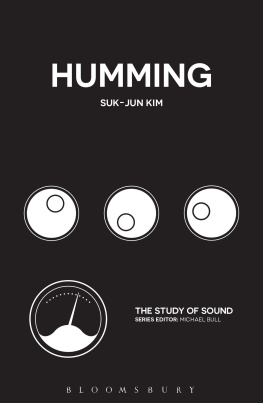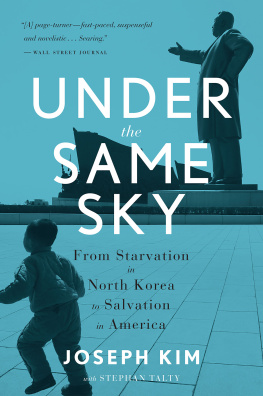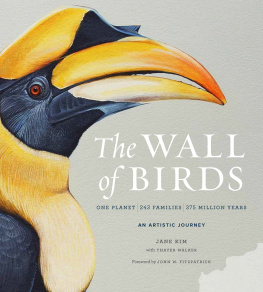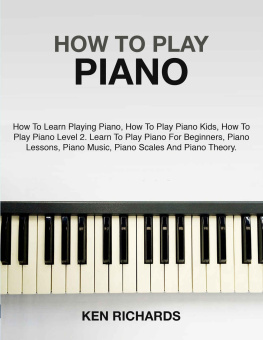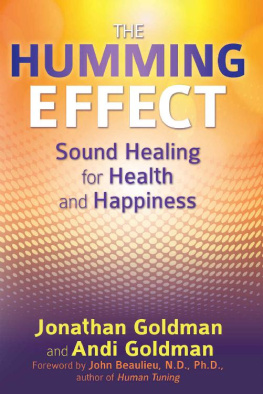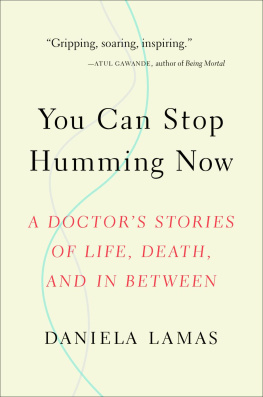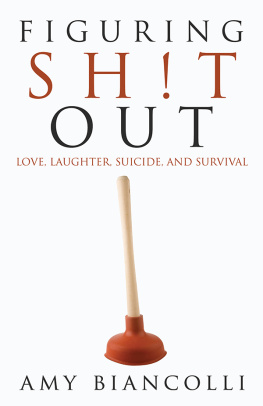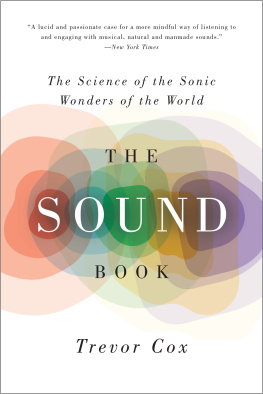Kim - Humming
Here you can read online Kim - Humming full text of the book (entire story) in english for free. Download pdf and epub, get meaning, cover and reviews about this ebook. City: New York;NY, year: 2019;2018, publisher: Bloomsbury USA;Bloomsbury Academic, genre: Religion. Description of the work, (preface) as well as reviews are available. Best literature library LitArk.com created for fans of good reading and offers a wide selection of genres:
Romance novel
Science fiction
Adventure
Detective
Science
History
Home and family
Prose
Art
Politics
Computer
Non-fiction
Religion
Business
Children
Humor
Choose a favorite category and find really read worthwhile books. Enjoy immersion in the world of imagination, feel the emotions of the characters or learn something new for yourself, make an fascinating discovery.
Humming: summary, description and annotation
We offer to read an annotation, description, summary or preface (depends on what the author of the book "Humming" wrote himself). If you haven't found the necessary information about the book — write in the comments, we will try to find it.
Humming — read online for free the complete book (whole text) full work
Below is the text of the book, divided by pages. System saving the place of the last page read, allows you to conveniently read the book "Humming" online for free, without having to search again every time where you left off. Put a bookmark, and you can go to the page where you finished reading at any time.
Font size:
Interval:
Bookmark:

To my wife, Sungeun
THE STUDY OF SOUND
Editor: Michael Bull
Each book in The Study of Sound offers a concise look at a single concept within the field of sound studies. With an emphasis on the interdisciplinary nature of the topics at hand, the series explores a range of core issues, debates, and objects within sound studies from a variety of perspectives and within a multitude of contexts.
Editorial Board:
Carolyn Birdsall, Assistant Professor of Television and Cross-Media Culture, University of Amsterdam, The Netherlands
Martin Daughtry, Assistant Professor of Music, Arts and Humanities, NYU, USA
Michael Heller, Associate Professor, Department of Music, University of Pittsburgh, USA
Brian Kane, Associate Professor, Department of Music, Yale University, USA
Marie Thompson, Lecturer, School of Film and Media, University of Lincoln, UK
James Mansell, Assistant Professor of Cultural Studies, Department of Culture, Film and Media, University of Nottingham, UK
Published Titles:
The Sound of Nonsense by Richard Elliott
Forthcoming Titles:
Sirens by Michael Bull
Sonic Intimacy by Malcolm James
Sonic Fiction by Holger Schulze

One cannot find an opportunity of knowing things if they are shown and experienced only through their smooth surface. The polished, even surface is, in a sense, an abstraction of things, a closed form, which would, perhaps, be sufficient if our aim were only to appreciate things as they are. Knowing things, however, expects us to move further than that. It is an act of seeking a gap, a crack, or an incongruity and making it visible, tactile on that calm and placid veneer. It is through this act that the surface of things becomes an open form.
Humming, to most of us, is a closed form. It is as such, not through a hard, glossy surface, but through its very abstractness. It is evasive and encourages us to look away, and yet, it captivates us, wrapping us in its spell. It is thus very hard for us with a mind of modern science that is, a mind with the tendency of being objective about things to know humming in its fundamentally aerial form. For me, humming became a subject for knowing when I discovered a gap, which, when I first identified, felt like an inconsequential and insignificant feature; that humming means two things: hums that we can make with our mouth shut, either tunes that we can hum or the very act of humming; and hums that have nothing to do with us, ones that we do not want to make, ones that we do not want to hear, such as electronic hums or traffic hums. What does this gap mean, this distance, and why such a distance? I had to ask. And this question led to more questions for which I wanted to find an answer, and through the initially unbridgeable distance emerged a certain field to posit and stand on. And just like that, this book started.
In the first chapter, My hums? Just about hums?, I question this very gap that seems to have curiously been neglected by the literature of sound studies. As I bring it to the fore and confront it, I take particular issue with the fact that the emergence of humming is in itself a secret, that is, the very production of humming is through ones mouth shut and lips sealed, an act of secrecy. This places humming in an unusual topology in relation to the study of voice, and specifically, that of psychoanalysis in which the voice, along with the gaze, is considered a key contribution of Lacan. In this chapter, therefore, I ask questions on the secrecy of humming through the lens of psychoanalysis, particularly, the discussions made by Dolar, Miller and iek, hoping to identify key features of humming and possible methodologies with which to examine its secrecy. In the second chapter, The Secrecy of Humming, I examine the peculiar relation of humming to its origin, the mouth, and how silence is borne out of this relation. I do this by conducting a case study of John Cages infamous performance/lecture piece, Lecture on Nothing. Much has been examined on Lecture on Nothing, but in relation to humming and its ontology of negation, I take a slight, yet, decisively different view on the piece, highlight four modalities of Cages silences. In doing so, I move onto the hums of the other. In the third, and final chapter, Hums of the Other, I explore the otherness of hums, first, by way of stories by Calvino A King Listens, Invisible Cities, and Six Memos for the Next Millennium and by Kafka The Castle, Metamorphosis, and The Burrow. This is followed by the examination of three features of humming the aphonic, the acousmatic, and the air which leads our discussion of humming back to the mouth and its oral imaginaries. Finally, I take humming as symptoms understood by Lacans and ieks psychoanalysis.
While many of the ideas in Humming had been developed through various artistic projects in the past, I could not have examined them as coherently and expansively as shown here without the help of Michael Bull, who saw potential through the quirkiness of the topic I proposed. I am also grateful to my editors Susan Krogulski, Leah Babb-Rosenfeld, and Katherine De Chant (I happened to have three editors!) at Bloomsbury Academic who graciously waited for and worked through my final draft. My thanks should also go to my colleagues at the Department of Music, University of Aberdeen, who have given me such understanding and confidence over the years and with whom I thoroughly enjoy working, to Gary Kendall who let me know that writing is like composing a piece of music, and to Paul Koonce, my mentor and friend, who taught me how to think.
Do you have songs that would remind you of your childhood?
Yes.
Could you hum some for me?
My hums? Just about hums?
This short book on humming began almost ten years ago. In 2009, I was in Berlin, working on a series of sound projects. One such project was to collect the hums of different people from Berlin. Titled the project required these different people to hum a tune that would remind them of their childhood. Collecting hums from approximately fifty to sixty people in Berlin to realize this project was a fascinating, and in a way, uneasy experience. Asking people who are strangers to you to hum a tune creates a series of fleeting moments that are tense and awkward. These moments, however short-lived and insignificant initially, are deeply felt; both by the person asking for the hum, and the person humming. The person doing the humming is left with the realisation that this task is considerably more difficult than he or she thought it to be.
It was not at first my desire to observe the behaviour of those who agreed to offer hums. But those awkward moments never failed to stop, intervene, and cut through the normality of whatever social, emotional engagements the person and I had had just before. Being strangers to each other, the social construct agreed upon between us was flimsy and suspected, bringing us to see and hear what humming did to those who hummed and those who listened to it. You can witness this action, this process of humming, for yourself. Ask anyone close to you, either in terms of physical or social distance; a stranger would certainly be better for this experiment of humming a tune. In order to ask someone to hum for you, you first need to consider how to approach him or her. This is not an easy task, precisely because you are well aware of what this request signifies: you are seeking the persons permission to be invited into his or her intimate, personal space. In a sense, it is as if you have been invited to their house, all of a sudden and without much chit-chat. If they agree to hum, you are in a contract with them bound by a certain trust, one that usually would take longer and require considerably more effort to build. But to your surprise, you realize that
Next pageFont size:
Interval:
Bookmark:
Similar books «Humming»
Look at similar books to Humming. We have selected literature similar in name and meaning in the hope of providing readers with more options to find new, interesting, not yet read works.
Discussion, reviews of the book Humming and just readers' own opinions. Leave your comments, write what you think about the work, its meaning or the main characters. Specify what exactly you liked and what you didn't like, and why you think so.

